GE Transport
April 12, 2024
What A Stuff Up!
Posted by gleneira under GE Governance, GE Service Performance, GE Transport[7] Comments
March 23, 2024
Heritage: Bayside Versus Glen Eira
Posted by gleneira under Councillor Performance, GE Council Meeting(s), GE Governance, GE Open Space, GE Planning, GE Service Performance, GE Transport1 Comment
Bayside council completed a Panel Hearing during February 2024 for its heritage proposed amendment C192. The report is not yet available. What is significant in this council’s approach to preserving heritage when compared to Glen Eira is the insistence on the ‘value’ of heritage to the entire community. The Glen Eira approach has simply stated that because council has identified certain areas as suitable for ‘housing growth’ heritage can be overlooked!
Bayside council’s submission to the recent planning panel is fascinating when seen in the light of Glen Eira’s approach. Our council tells us repeatedly that there could be serious ‘social’ and ‘economic’ drawbacks if certain sites are allowed to remain in the existing heritage overlays. They can therefore be removed. Bayside counters such views with the following extracts from its formal submission. We’ve uploaded several sections from this document. Please note the differences in approach and what this means for heritage preservation.
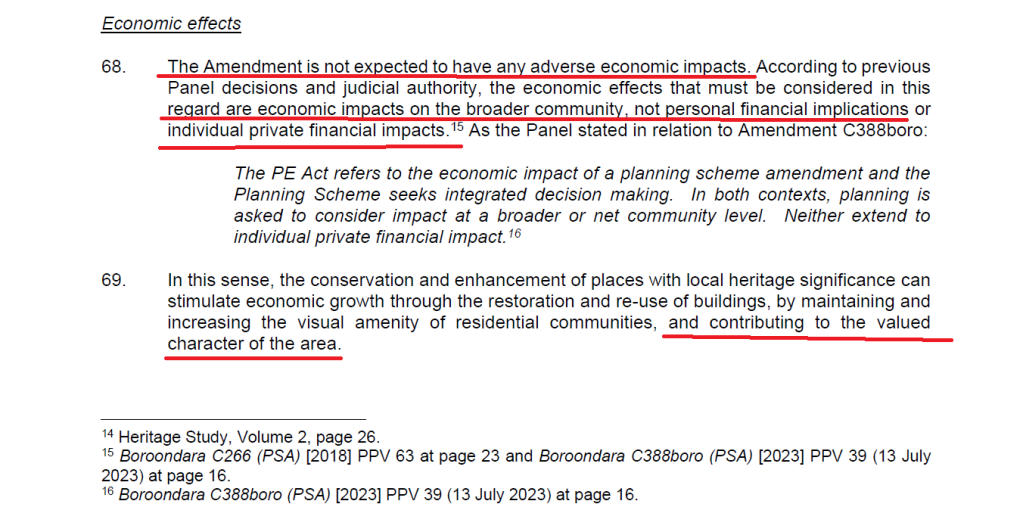

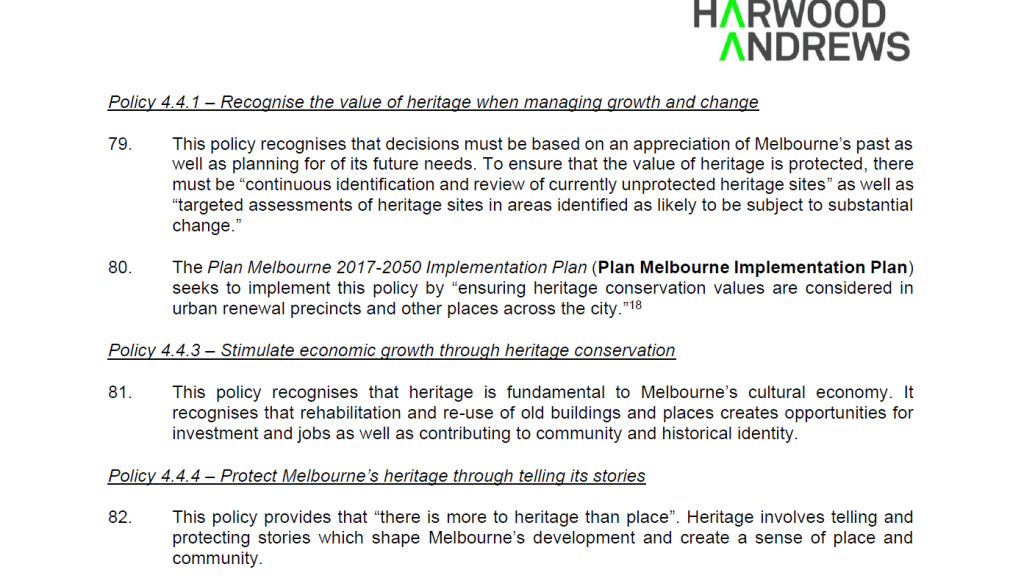
March 20, 2024
Heritage Versus Development!
Posted by gleneira under Councillor Performance, GE Council Meeting(s), GE Governance, GE Planning, GE Service Performance, GE Transport[3] Comments
Despite persistent claims from councillors and this administration that preserving heritage is vitally important, last night’s council meeting provided conclusive proof that in the choice between facilitating development or preserving heritage listed sites, heritage would always lose.
The issue surfaced with the proposed amendment to the Elsternwick heritage study which is now seeking ministerial approval for advertising. Repeated time and time again throughout the various attachments we find the following (verbatim) paragraph:
Including these sites within a Heritage Overlay would negatively impact on potential future housing growth within locations that Council has resolved to allocate to housing growth. This inconsistency has social and economic implications. When balancing Council’s adopted strategy for housing growth opportunities in these locations with heritage protection, it is considered that in these two instances, housing growth should prevail.
We note that there is no explanation of what these ‘social and economic implications’ are, nor how they are assessed and verified. Surely the preservation of heritage buildings has its own wider, ‘social’ benefits?
All of this stems back to 2019 when council attempted to have amendment C203 accepted. The Minister or department decided at that time that not all the nominated precincts be included because this would impede development. A department letter to council stated:
“At this stage it is not considered appropriate to apply the Heritage Overlay more extensively in Elsternwick given that Council is yet to seek authorisation for a planning scheme amendment to implement the Elsternwick Structure Plan. Doing so could, by default, lead to heritage controls becoming the primary driver for development outcomes within the Elsternwick Activity Centre.
Council’s response? Not a whimper! No public questioning of the legality and common sense in 2019 and not again in 2024. Council meekly accepted the decision and has now enshrined this in the latest amendment attempt. The result is the continued loss of heritage buildings in Glen Eira, and particularly in Elsternwick.
When Amendment C203 finally went to a planning panel, the members were not averse to stating clearly their disapproval of the imposed conditions. We have uploaded two pages from the panel report at the conclusion of this post. Their conclusions questioned the legality and evidence for the exclusion of the nominated precincts. They found that the amendment:
1. Is counter to Planning Practice Notes 1, 58 and 60 and that
2. Development potential is not a valid criterion when considering heritage potential.
3. Development potential is NOT prioritised above any other criteria in the planning provisions
4. No valid justification has been provided for the exclusion of the precincts
5. Contravenes Plan Melbourne where heritage is said to be ‘fundamental’ (Clause 4.4.3) to the state’s cultural identity.
Last night’s officer’s report confirms what an absolute shambles planning, and particularly heritage has been in Glen Eira. The latest amendment is simply trying to largely rectify the indifference and errors of the past when countless streets containing confirmed heritage overlays were rezoned as Residential Growth Zones (RGA and 4 storeys) when they should not have been! Here’s what the latest heritage report states:
The application of the RGZ in these almost exclusively residential Heritage Overlay areas is contrary to the guidance of PPN91 (Planning Practice Note 91 – Using the Residential Zones), which identifies that there will be difficulty in reconciling the conflicting objectives of substantial housing change (through the application of the RGZ) and the conservation of existing buildings (by applying the Heritage Overlay).
In other words, the introduction of the residential zones in 2013 was a disaster for heritage. Many sites in these heritage overlays have now been demolished and replaced with 4 storey apartment blocks as a result. We remind readers that we are yet to see a full and decent review of this zoning!!!!!
Our argument is simple. If something is determined to be worthy of heritage listing then it MUST take precedence over development potential. Council chooses the alternative – development always comes first!
The vote last night was 7 to 2. The opposing councillors were Esakoff and Parasol and NOT because they were against the removal of so many heritage sites, but because they wanted one nominated dwelling removed from being included in the overlay, even though it is surrounded by heritage cited properties! So much for giving a damn about heritage in Glen Eira!!!!!
Here’s the Planning Panel report comments –
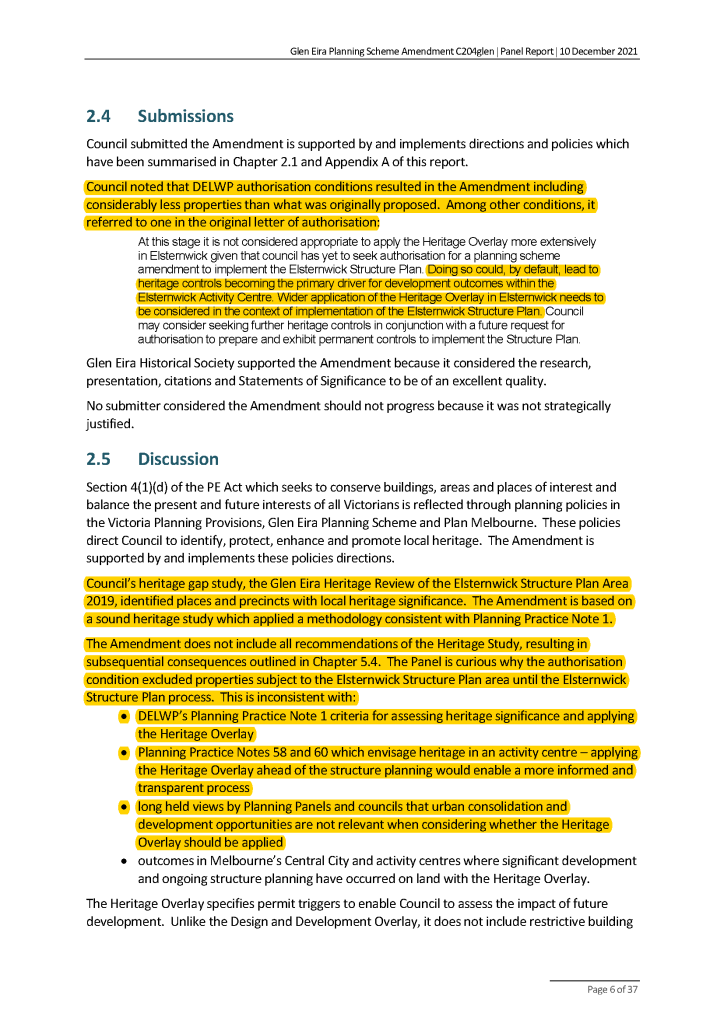
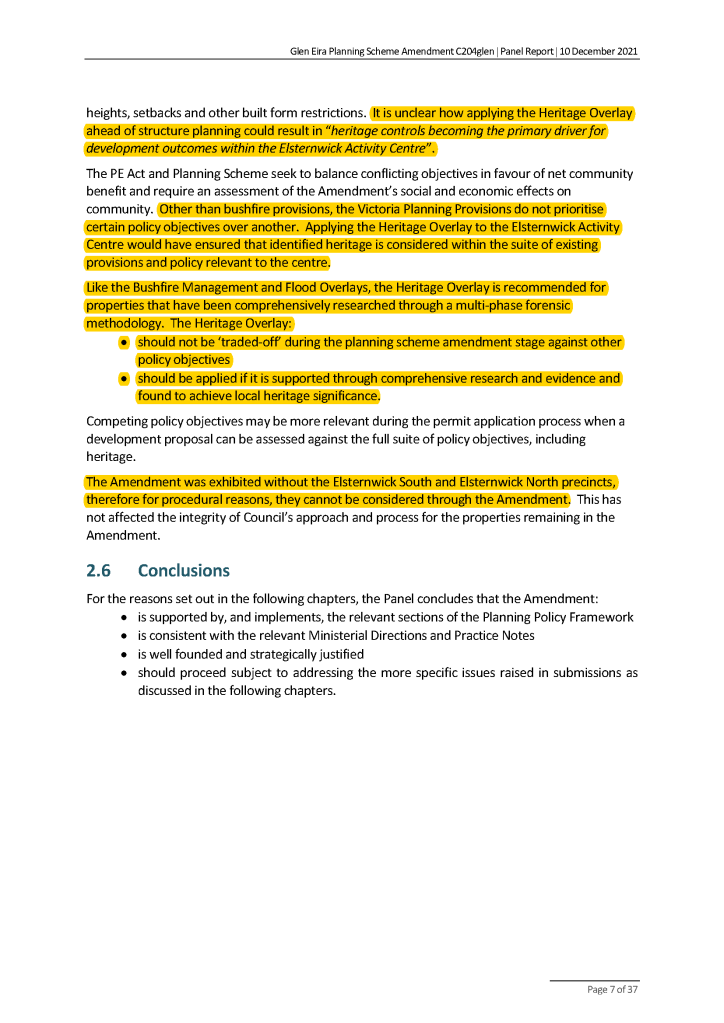
January 31, 2024
Why Genuine Consultation Is Dead In Glen Eira!
Posted by gleneira under Councillor Performance, GE Consultation/Communication, GE Governance, GE Open Space, GE Planning, GE Service Performance, GE Transport[9] Comments
Over the past few years more and more residents are feeling aggrieved at the bogus consultation methodologies that this council trots out. Here is a summary of what is wrong with the entire process –
- Survey questions are designed to elicit the required response. They are either totally irrelevant to the core issue or are simply vague and nothing more than motherhood statements. We are not told who designs these questions but more importantly whether they are first road tested with councillors and the community consultation committee. The latter group remains nothing but a public relations enterprise given that they have no real input into design or decision making of surveys or issues.
- Public forums are also carefully manipulated and engineered. Half of the time officers present their (positive) take on an issue and little time is left for resident queries and comments. Secondly the chat function is often turned off so that participants can’t communicate with each other and again recordings of the forums seldom are available to review. The latest forum on the Queen’s Avenue trees is the perfect example with council stating that they can’t release the video because of LXRP ‘requirements’ and conversely the LXRP stating that it is council’s forum and hence up to their discretion.
- Consultation summaries are anything but accurate representations of what was stated. Often residents have to be satisfied with a sprinkling of what participants said instead of being able to read in full everything that everyone stated. FOI requests are met with sheer nonsense such as releasing all commentary would be an impingement on council resources and take time away from their other business. When the survey responses are anonymous and collected in a single file the excuse of a drain on council resources is sheer bunkum!
- Often residents find themselves having to plough through hundreds upon hundreds of pages in order to get to the crux of the matter. Council refuses to provide short summaries of the major issues so that residents can know exactly what is at stake.
- Meetings with officers are generally a waste of time. They trot out all the positives but neglect any negatives. Furthermore the times set aside for such activities are mostly during the day – hardly suitable for people who work, or have small children.
So how can all this be fixed? Here are some suggestions that we’ve made in the past –
- Ensure that survey questions are reviewed by both councillors and the community consultation committee before anything goes public. Avoid generalities, closed questions, motherhood statements. Provide a short, succinct summary that addresses all the pros and cons of the matter. For major issues a Discussion paper is vital.
- Given that council was quite prepared to release all commentary on its consultations several years ago, the current approach on the most contentious issues such as structure planning and the housing strategy, has been to cover up and hide as much of the negative feedback as possible. This has to change. All comments, emails (redacted to protect privacy) must be available.
- Major consultations remain at the ‘consult’ level. According to the IAP2 we should surely be at the very least at the ‘involve’ level. Councillors have the power to ensure this occurs.
- Forums either public or Zoom must include the chat facility so that participants can interact. Secondly the full version must be available for those who missed out. The focus should always be on resident feedback and NOT officer reports.
- Finally, it is imperative that before residents are asked for their views, all information is provided to them. We have had councillors complaining that they don’t get to see some documentation prior to their voting, or that not sufficient time has been provided for them to digest the data. Residents also need to have all the facts before they commit to providing responses.
All of this is important if the community is to have any faith and confidence in this council. Refusing to implement genuine consultation only serves to foster suspicion and shows how the essential priority of transparency is moribund in Glen Eira.
January 10, 2024
Why Is Glen Eira So Against Developer Levies?
Posted by gleneira under Councillor Performance, GE Governance, GE Planning, GE Service Performance, GE Transport[6] Comments
Over the past few years we have heard time and again that rate-capping and cost shifting by federal and state government has caused uncertainty in Glen Eira’s ability to resource all its services and infrastructure. This has resulted in the closure of our early learning centres and the attempted sell off of aged care.
But how much is this financial ‘stress’ due to Glen Eira’s own grandiose plans and refusal to impose any sort of financial imposte on developers? In 2016, the planning scheme review noted time and again full resident support for a development contributions levy (DCL) and even a car parking waiver levy. Glen Eira used to have a DCL but it was allowed to expire in 2010 and has never been reintroduced. Even when the latest structure plans came up for decision the officers’ reports paid short shrift to the idea of introducing such a levy. Over the years we have had statements such as the following:
Incorporating a Development Contributions Plan into the Planning Scheme for Carnegie will not be able to be undertaken as part of Amendment C184 due to the length and complexity of this process and may be worth examining at a later date. (January 2020)
And in the November 2023 planning scheme review (without community consultation!!) we were told that the DCL is: On hold. Pushed back owing to other major strategic planning implementation, such as controls to implement structure plans.
Thus, since 2010 Glen Eira residents have been subsidising developers and there is no indication when this largesse will cease!
Other councils thankfully have not been so backwards in getting their priorities right and working to ensure that their residents aren’t subsidising developers to the hilt. The following screen dumps are all from councils which have been successful in introducing a DCL in the past 18 months into their planning scheme as well as a car parking waiver
WHITEHORSE
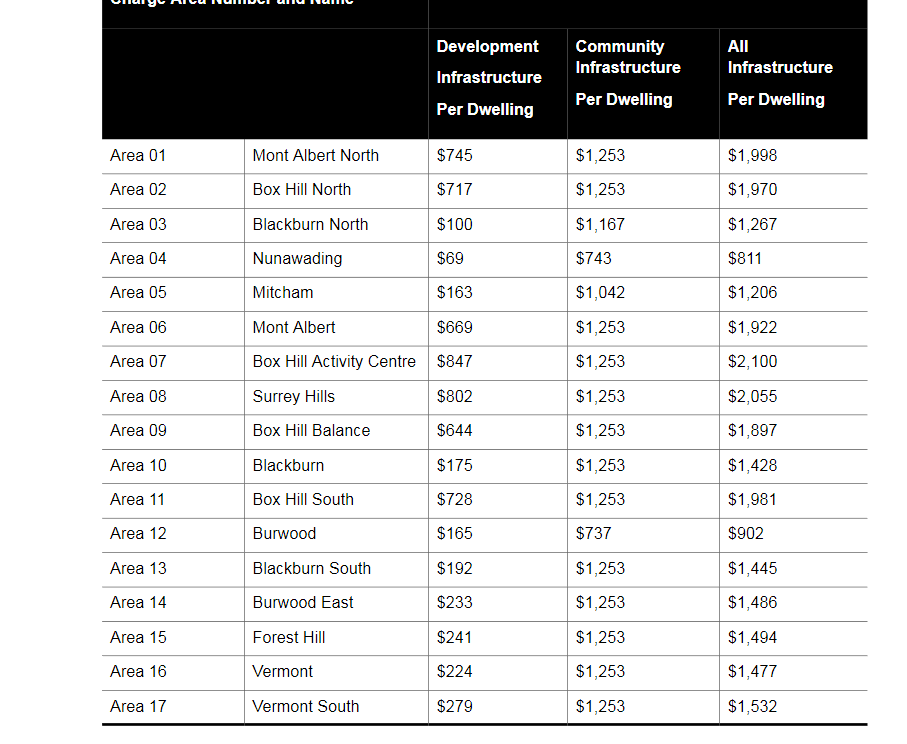
STONNINGTON
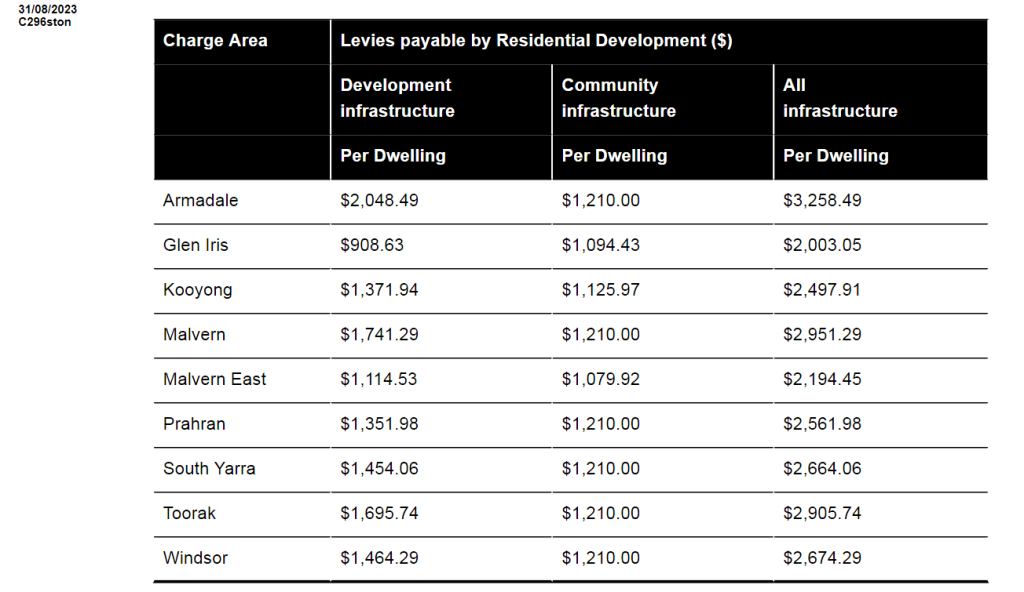
MERRIBEK
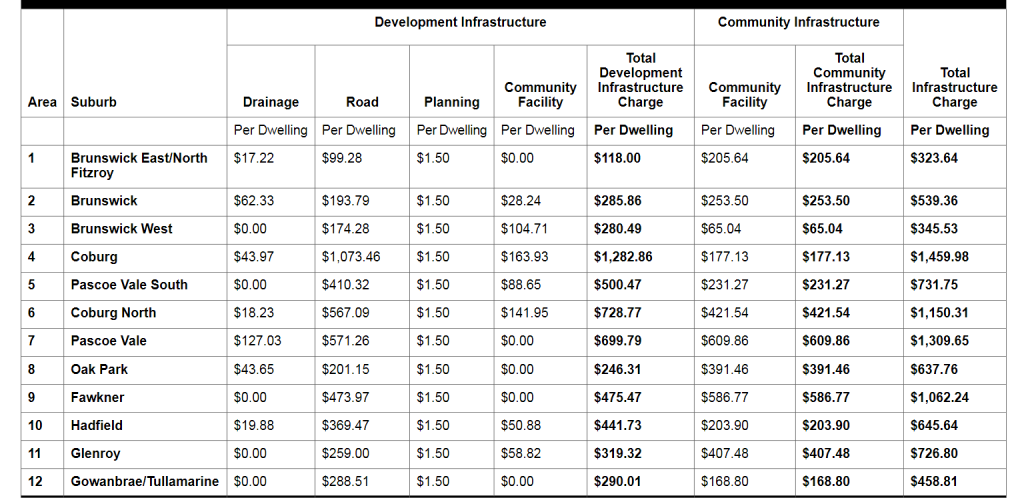
MARIBYRNONG
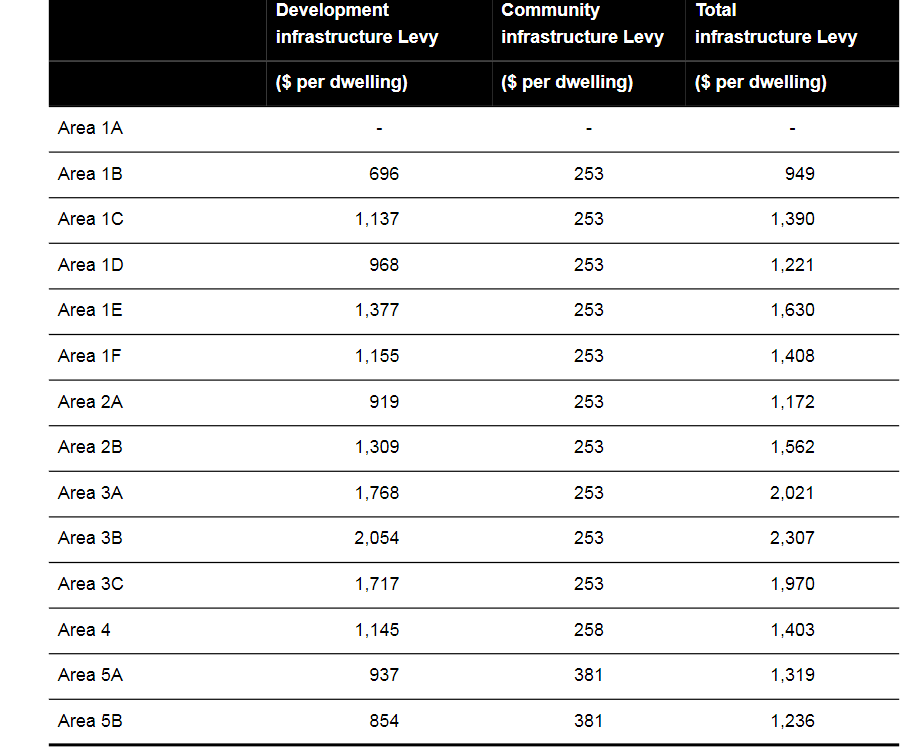
BRIMBANK

The first screen dump is from Whitehorse council. For its Box Hill Activity Centre the levy is $2,100 per residential dwelling. Glen Eira forecasts over 2000 net new dwellings just for Elsternwick alone. Doing the sums, with a DCL comparable to Whitehorse that could bring in over $4,000,000!!!! Add to this all the other major activity and neighbourhood centres alone, then the income could well and truly be hitting the $20M mark.
AND SOME CAR PARKING LEVIES



Over the years Council’s excuse for not (re)introducing a DCL was that the cost involved far outweighed the benefit! Surely this kind of argument would also apply to all of the above councils? Yet they have forged ahead. If the cost was truly prohibitive then surely they would have refrained?
The question remains: if other councils can achieve the gazetting of their DCL’s and car parking levies, then why is Glen Eira so reluctant to introduce something that was promised seven years ago and hasn’t existed for 14 years now? Instead of continually crying wolf and bemoaning rate capping etc Glen Eira Council needs to look at its own back yard. It can increase its revenue via these levies! It can cut spending by refusing to build taj mahals that are in the vicinity of $85+M and incurring massive interest repayments for the next decade and more. It can reduce spending on useless ‘consultations’ that are anything but genuine. There is no excuse possible for the failure to rein in costs and to source new revenue funds via these developer levies. Maybe then council might stop trying to flog off all our services such as childcare, aged care, home support, etc.
December 30, 2023
What A Year!
Posted by gleneira under GE Consultation/Communication, GE Governance, GE Kindergartens/Childcare, GE Open Space, GE Planning, GE Service Performance, GE Transport[3] Comments
With the close of the year just around the corner, we thought we would take a look back at what occurred throughout 2023 and what this reveals about council and its performance.
February 2023
- A resolution to spend $75,319,095 (EXCLUDING GST) for the Carnegie Swimming Pool redevelopment. That makes it well over $80M. By the time this is built we could be looking close to $90M. We also have huge borrowings and no disclosures as to the interest rate payable, nor whether these rates are variable or if fixed, for what period. One could also question whether we really need another mini GESAC?
March 2023
- Not for the first time we have councillors complaining about the lack of information and appropriate time to evaluate officer’s reports before being forced to vote on the items. Please listen again – https://gleneira.files.wordpress.com/2023/03/711_0385.mp3
- Given the declaration of a Climate Emergency and an Urban Forest Strategy, the adopted 2022/23 budget REDUCED the spending on the planting of new trees to $827,000 when in the 2021/22 budget it was $1,350,000!
April 2023
- The decision to only publish ‘summary reports’ on community consultations when in the past the complete raw data was available reeks of a cover up – especially when the summary reports are vague with a predominance of such terminology as ‘several’, ‘many’ ‘some’. There is the continued failure to ensure that the actual survey questions are of quality and that they have gone through a proper testing process that involves councillors and the Community Consultation Committee.
May 2023
- An Elsternwick forum of nearly a 100 residents turning up to voice their views on the draft Elsternwick Structure Plan. Result? No recognition or addressing the issues raised.
July 2023
- Structure Plans that more often than not scrape through on the casting vote of the chair.
August 2023
- Governance failures galore when Pennicuik was suddenly forced to declare a conflict of interest on the Elsternwick structure plan which meant that the final decision was again decided on the mayor’s casting vote. Several months later however, Pennicuik could vote on the Elsternwick amendment and nothing had changed since the acceptance of the draft structure plan!!! Amazing!!!
- Miraculously, Glen Eira does have a Notice of Motion. But this was because of a huge stuff up in the writing of their governance rules and had nothing to do with the intent of the original wording. The aim was to prevent councillors from having items put on the agenda. It will be interesting to watch the upcoming version of the local law to see whether they keep trying to silence councillors in this fashion.
September 2023
- More stuff ups in that the proposed pop-up park in Orrong Crescent was deemed ‘illegal’ since it depended on a road closure which had not been advertised and consultation called for. Ultimately this was abandoned, but how much have all the shenanigans cost?
- More dubious consultation ‘summaries’ on Bentleigh & Elsternwick that pay scant attention to resident views
October 2023
- Announcement of the secret meeting that decided on the ‘preliminary’ closure of the early child care centres. Consultation would now follow the decision!!!! Repeated claims about the legitimacy of the decision and the need to abide by the Local Government Act. We could not find anything in this Act which demanded a ‘preliminary’ decision!
December 2023
- The decision to close the early child care centres for the paltry saving of $500,000 per annum. Plenty of public questions which queried the accuracy of the ‘discussion paper’ and some of the claims made by council.
CONCLUSION
2023 has largely been a disaster for residents. Here’s why –
- the administration has steam rolled ahead with its agenda of rubber stamping major developments and structure planning that will facilitate more and more high rise – regardless of whether or not these new developments are needed to ensure that council meets the projected population growth.
- Community views are treated as mere annoyances and basically ignored
- Lack of transparency in decision making
- Councillors denied timely access to all fundamental information to inform their decision making
- No public announcements on whether or not there is progress on increasing tree canopy targets. No statements about cost savings or improved efficiencies.
- Consultations remain nothing more than exercises in legal requirements with no intention of asking questions that would reveal what residents really think and desire.
Finally, we wish all our readers a healthy and peaceful 2024! Thank you all for your continued support!
December 5, 2023
Victoria In Future 2023!
Posted by gleneira under Councillor Performance, GE Governance, GE Open Space, GE Planning, GE Service Performance, GE Transport[4] Comments
In September 2023 the state government released its latest version of Victoria In Future (VIF). Promoted as a yearly document, this one only took four and a quarter years to materialise! Councils are directed to base their strategic planning on this document. What is interesting about this latest prognostication is that instead of Glen Eira’s projected 188,000 in the 2019 version, the 2023 version projects the number of residents in 2036 to reach 174,000. In terms of dwellings required this has now changed from 78,500 to 79,090. Thus VIF 2023 projects that between 2021-2036 Glen Eira will require 12,850 net new dwellings to meet population growth needs.
The latest VIF data can be accessed via https://www.planning.vic.gov.au/guides-and-resources/data-and-insights/victoria-in-future
Glen Eira however continues to base all its strategic planning on facilitating far more than 13,000 net new dwellings by 2036 as evidenced in its latest structure plans, the housing strategy and Amendment C220. If our projected population has dropped by 14,000, together with a decline in required housing, then why are we still going full bore for more and more development?
If we look at our major planning documents (ie structure plans and priority development zones) and what these documents forecast, the true picture reveals itself. Background papers for these plans forecast the following (conservative) numbers of net new dwellings over the next 15 years –
Glen Huntly -410
East village – 3000+
Caulfield village/Caulfield Staion – 3,500+
Bentleigh – 2388
Elsternwick – 2000+
Carnegie – 2,500+
TOTAL: 13,798
It should also be remembered that both Caulfield and East Village are only ‘preliminary’ figures. In both cases they can well and truly exceed these forecasts as the permit for East Village has already enshrined! Thus if we simply focus on the above we already surpass the proposed target, without even counting development that is occurring in our eleven neighbourhood centres, and residential areas. Yet council is not satisfied, and with the housing strategy recommendations ALL of Glen Eira will be turned into a developer’s paradise.
Please note that our Housing Strategy and Amendment C220 forecasts the rezoning of over 10,000 sites and this includes the removal of the mandatory garden requirement for ALL sites zoned General Residential zone, and the creation of a new zone NRZ2 which will increase the permissible site coverage and reduce current permeability requirements. All engineered to allow more and more development on single sites.
When other councils are trying their hardest to stop their municipalities becoming congested and environmentally unsustainable areas, Glen Eira is doing everything it can to achieve the opposite. Here as some example quotes from these councils’ Housing Strategies. Compare these with the Glen Eira vision and what is proposed:
Boroondara
The BHS (Boroondara Housing Strategy) recognises that the need for housing diversity should also be considered in conjunction with the capacity and functions of key infrastructure, such as roads, sewerage, drainage, public services and public transport. If these services cannot sustain additional population in particular locations, it would be unsustainable to increase densities in these locations until the necessary infrastructure can support the change. (page 2 of the Housing Strategy)
COMMENT: In the Glen Eira documentation, there has been no assessment that we are aware of which provides any analysis of existing infrastructure and future need. No costings have been provided; no time-lines have been provided, and no evidence to support the sustainability of 13000+ net new dwellings.
Bayside
The Review also found that Bayside’s growth locations have sufficient housing capacity to meet anticipated population increases over the next 15 years to 2036 as required by State planning policy. (page 3)
….the overarching spatial approach outlined in the Housing Strategy, 2012 and in this update to the Housing Strategy, is delivering increased housing in Bayside in locations that are well served by public transport, shops and services. This is the most sustainable approach to delivering increased housing density and is in line with State Government planning policy. Should further housing capacity be required in the future, a future review of the Housing Strategy can consider other locations that may be suitable for increased housing density in addition to those already identified in the Housing Strategy. This approach allows Council to direct and manage growth in the short to medium term. (page 6)
Retain the existing residential zoning in Bayside. This clearly implements the Housing Strategy’s vision and spatial approach to managing housing growth in Bayside
COMMENT: Bayside sees no need to change zoning given the growth in its major activity centres. Glen Eira on the other hand intends to ensure that 10,000 sites will be rezoned when our major activity centres alone can meet projected growth.
YARRA
As shown by the assessment of the Yarra’s activity centres to accommodate future housing growth, Yarra can rely on existing capacity and does not need to make significant changes to rezone other land at this time to provide additional housing supply. If housing delivery trends continue to be strong in Yarra, within the next 5 to 10 years it will be important to identify key precincts to undertake further strategic planning to identify long term housing land availability. (page 67)
COMMENT: Yarra takes a similar approach to Bayside. Capacity is sufficient and if there is a need for more dwellings then this can be addressed at the time. In Glen Eira, policies/zonings once introduced stay there forever. The residential zones introduced secretly in 2013 have not had a thorough review, and certainly no public consultation. No attempt has been made in 12 years to address shortfalls in permeability and site coverage requirements when countless other councils have up to 40% permeability requirements for their General Residential Zone areas. And yet, we are supposed to have an Urban Forest Strategy and a concern about sustainable development.
CONCLUSION
With the latest projections provided by VIF 2023, council must review its strategic planning and assure residents that development at all costs is no longer necessary nor sustainable in our municipality.
December 2, 2023
More Sleight Of Hand?
Posted by gleneira under Councillor Performance, GE Consultation/Communication, GE Council Meeting(s), GE Governance, GE Open Space, GE Planning, GE Service Performance, GE Transport1 Comment
Not for the first time do we have council handing over full control of planning to the Minister and the Department. We ask readers to carefully compare and consider the following screen dumps. They involve adopted amendments and the resolution to send the amendment to the Minister seeking approval for advertising and formal submissions.


The Whitehorse resolution contains no mention of the Minister or the Department as does the Glen Eira one. One may quibble as to the interpretation of ‘intent’ but giving the Minister the right to change whatever he likes can still fit into ‘intent’ given that this basically means to produce documentation for land use.
Here are a couple of other resolutions from Boroondara and Stonnington. Again, note the absence of mention of Minister and/or department.


So why has Glen Eira resorted to the inclusion of this phrasing when other councils haven’t? The repercussions can be immense as proven previously with the increased heights for Carnegie and Elsternwick through the interim DDO’s. It also means that residents will not have any future say – it will be fait accompli. Instead of ensuring that what was decided upon remains, this clause simply allows more changes without community input.
November 24, 2023
Bentleigh Structure Plan – Feedback Summary
Posted by gleneira under Councillor Performance, GE Consultation/Communication, GE Council Meeting(s), GE Governance, GE Open Space, GE Planning, GE Service Performance, GE Transport[5] Comments
Once again a whopping agenda that lumps together some of the most important planning issues that confront the community. These are:
- Bentleigh Structure Plan community feedback
- Bentleigh East Neighbourhood Centre amendment
- Elsternwick Structure Plan amendment
- Carnegie Structure Plan amendment
Very little has changed in regard to the Major Activity Centres, especially in relation to heights, and overshadowing. All this despite the fact that the majority of responses were opposed to various recommendations in the structure plans and the mooted DDO’s. Carnegie did not even have community consultation following the abandonment of version one (ie Amendment C184)!!!!!!!
We will deal with each of the above as separate posts beginning with the Bentleigh consultation summary.
Bentleigh Community Feedback ‘summary’
- There were 106 survey responses, 17 emails and a petition of 221 signatories. Council states that it sent out 4,101 letters to surrounding households. The feedback equates to a pathetic 2.56% response rate for the survey. Why? Are Bentleigh residents so apathetic that they don’t care? Have residents given up on believing that their voices can affect outcomes in Glen Eira? Or is there something drastically wrong with the way in which council communicates its intentions? We have yet to see any analyses EVER of why feedback is so low and what can be done to improve this. It serves council well to simply go through the motions of ‘consultation’ despite the fact that survey after survey has been anything but a genuine attempt to elicit relevant and valid responses.
- Again, we are not privy to the raw data. No publication of the responses as has happened in the past. Instead we have a ‘doctored’ summary that falls far short of reporting on what was actually said/written.
- Language used remains a problem. The officer’s report is vague and imprecise with terminology such as ‘mixed responses’, ‘about half’, ‘support for accommodating growth’, ‘some support’, etc. Very little is quantified.
- The summary report itself is nothing more than a public relations exercise. For example: On ‘retaining character’ we find this conclusion in the report – 55 percent of participants indicated that accommodating growth above the commercial strip was better than doing it in other parts of Bentleigh. Ostensibly this sounds like a majority are in favour, but one must query the value of the question itself. There could very well be support for greater density in the commercial core, but THIS DOES NOT MEAN that respondents are in favour of 8 storeys (discretionary) adjacent to heritage homes. The value of any response and what conclusions might be drawn are 100% dependent on the quality of the questions asked. The online survey as we’ve commented on before was carefully engineered to avoid as much as possible any responses that could be interpreted as ‘negative’ or opposed to the recommendations of the structure plan.
- The above criticisms can also be directed to this conclusion – 51% of participants indicated they ‘strongly agreed’ or ‘agreed’ that measures such as height limits and upper-level setbacks for new development would help to retain the character of Centre Road. Of course people want height limits. But we were never asked what those height limits should be!!!!!!!
- On page 4 of the summary report we are told that 20 percent of participants indicated they would like a building height limit reduction in the centre when asked about retaining character in a growing centre. This sounds like a clear minority in favour of reduced height limits. But this alleged 20% is only from those individuals who took the option to write something in the text boxes. And again, no question asked what is an appropriate height limit?
- More concerning is that the above cited 20% does not correlate with what is then presented in the following table:

We’ve highlighted all those responses which could be seen as pertaining to the issue of height. The totals are far in excess of the previously stated 20%!!!!!! However, without full publication of all the responses then it is not possible to determine whether the 20% is anywhere near accurate or council’s fudging of the responses. Transparency is again the victim in this reporting.
CONCLUSION(S)
Until this council is prepared to undertake genuine consultation that includes full oversight by councillors and the community engagement committee in the drafting of survey questions then residents cannot hope to be participants in anything but a carefully orchestrated farce that fulfils legal requirements and nothing else. Nor can residents have any confidence in the resulting feedback summaries when the raw data is with-held. When council fights so hard to avoid full disclosure one must surely doubt the results.
As stated earlier, there must be a full analyses of why consultation in Glen Eira is such a failure in terms of community feedback. This should start at the first stage of notification to residents – are they provided with enough detail to engage their interest/concern? Are they expected to undertake hours of reading that involves hundreds of pages instead of succinct summaries? And how many residents have simply given up because they don’t believe that anything they put forward will eventuate? This isn’t apathy we believe. It is simply distrust of council and the predetermined nature of all decision making. If residents truly believed that council was ready to listen and act, then we are confident that feedback would quadruple and that residents could actually believe that council was acting on their behalf. Sadly this is not the modus operandi of Glen Eira City Council!
November 22, 2023
Boroondara Versus Glen Eira
Posted by gleneira under Councillor Performance, GE Consultation/Communication, GE Governance, GE Open Space, GE Planning, GE Service Performance, GE Transport[3] Comments
Earlier this month Boroondara City Council voted in a resolution which basically condemned the flurry of planning changes introduced by the State Government over the past 18 months or so. The vote was a result of a detailed officer report outlining the consequences of these changes and how they would impact the Boroondara community. In Glen Eira, apart from a bit of fear mongering by some councillors used to justify their voting patterns on activity centres (ie we would get worse results if the minister calls it in, blah, blah, blah) there has not been one report, analyses, or discussion similar to the Boroondara stance. In all likelihood, residents have no idea of what these changes to the planning system entail, or what they mean for future development.
If councils are truly working for their residents, then it is incumbent on them to provide their communities with the necessary information and to work collaboratively with various community groups in their advocacy roles. None of this has happened in Glen Eira. Why not? Why can’t we have an officer’s report which is out in the open and discussed in council chambers so that everyone knows what this council stands for?
The Boroondara vote can be watched via https://www.youtube.com/watch?v=h4f_0Tab2Ag. It starts at approximately 52 minutes into the webcast. We’ve also uploaded several pages from the officer’s report. It was lengthy, but the highlighted comments here are important and reveal the primary concerns of Boroondara. Are these shared by Glen Eira? Who knows?



Again, we have a myriad of questions:
- Have councillors even been briefed on what each new piece of legislation means?
- Have options been presented to councillors on what can and should be done in response?
- What communications have taken place between officers and departments? Have councillors been made aware of all such communications? If so, have they seen hard copies of this communication or simply had to rely on officer’s verbal summaries?
Residents deserve heaps better from our council. Or is the truth simply that the Glen Eira administration is fully behind the government’s actions in removing as far as possible all third party objection rights and allowing more and more development?